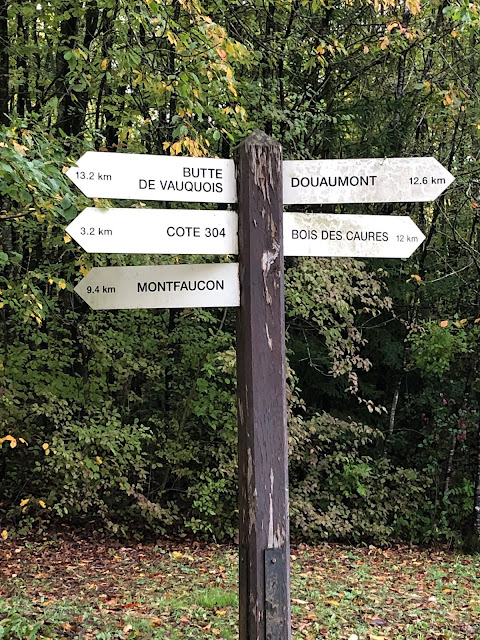We started at one of the few French national cemeteries, the Douaumont National Cemetery. The vast majority were killed in the Battle of Verdun, There are 16,000 grave markers and the basement of the memorial building contains the bones of another 130,000. There is also a separate Muslim cemetery for the colonial troops and another for Jewish troops.
Stephen and I both walked the 227 steps up to the bell tower.
You can view the bones through windows in the basement.
Verdun is surrounded by numerous forts (32) built after the Franco-Prussian War of 1870. Verdun is very near the border with Germany and it was expected that any German invasion would come through Verdun. It didn't. Fort de Douaumont is the largest of these forts with an extensive underground maze of tunnels and bunkers.
The French stripped most of the heavy guns originally contained at the fort and sent them up to the Somme back in 1915. When the Germans initiated their Verdun campaign in February 1916, the fort was essentially undefended and the Germans easily took control. The French tried repeatedly to retake the fort and finally did so in October 1916.
When the Germans took over the fort, they had to do some modifications since the fort was built with its "face" to the east, Germany. Now that the Germans controlled the fort, they found the windows, doors and thin walls were on the French side of the fort. So, they had to reinforce the west facing part of the fort and installed firing slits and positions.
This is the German cemetery deep within the fort. There are over 600 German soldiers behind this wall. They were killed accidentally when one of them decided to heat coffee with a hand grenade. The result was the detonation of hundreds of rounds of artillery shells. Not being able to take them outside for burial, they walled them up.
The fort is a damp and cold place.
The outer turret of the fort's 115mm cannon. It can swivel a full 360 degrees. The turret will retract downward so that there is virtually nothing to see (or shoot) except the rounded dome.
Machine gun and smaller cannon turrets on top of the fort, facing east, Germany,
There firing positions were added by the Germans, facing west, France.
We then went to the Verdun Memorial
We then visited one of the several towns that was totally destroyed during the battle. It was never rebuilt. Verdun has the distinction of being the most shelled location in the world. There is still many undetonated shells everywhere. It is also a mass grave site. Bones are commonly uncovered and merely to those in the basement of the Douaumont National Cemetery.
After the war, the French surveyed the country side and designated Blue, Yellow and Red areas. Blue areas were only slightly damaged and considered safe. Yellow areas were in need of reconstruction but could become safe to reinhabit. Red areas were declared to heavily damaged and not worth the cost to make safe to inhabit. The area around the Verdun battle site is a Red area.
The French put memorials in some of the destroyed towns and markers as to what used to be where,
Our last stop was at a memorial built by French veterans. It is a grim statue of Death draped in a French flag.
 |
| Our new hotel for the next three nights |

























































































No comments:
Post a Comment